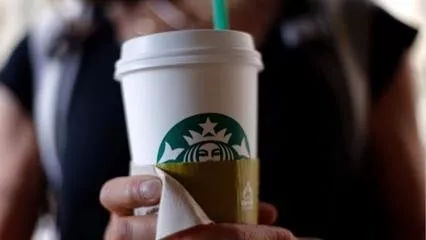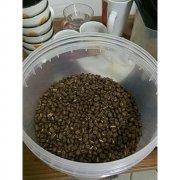How is Starbucks decaf brewed? How do I order Starbucks decaf coffee?

Professional coffee knowledge exchange more coffee bean information please follow the coffee workshop (Wechat official account cafe_style)
The origin and development of decaf: why are all Swiss decaf sold?
How is Starbucks decaf coffee made?
Drink coffee, natural. It's best!
∼ is not recommended for both decaf and decaf.
Starbucks can remove caffeine in two ways:
1. Direct contact method:
First of all, soften the green beans in warm water. Add a chemical [methanol chloride]
The melting point of this chemical is very low. It will be completely destroyed at 40 degrees. The temperature of brewing coffee is usually between 93 degrees. So Starbucks' decaffeinated beans don't contain methanol chloride.
After adding, release the caffeine from the coffee beans. This way can effectively preserve the flavor of coffee beans. The released caffeine can also be resold to drugmakers as painkillers or to beverage manufacturers to make beverages containing caffeine! The low-coffee beans sold by Starbucks are coffee beans with 99% caffeine!
two。 Swiss washing method:
This way is to soak the green beans in warm water. Dilute the caffeine from the beans into the water.
In separating the water from the coffee beans. At this time, the flavor and caffeine of the beans only went into the water.
This kind of water is called flavor water. After that, the flavored water is filtered out of the caffeine with activated carbon. Soak the caffeine-filtered flavored water in the beans. Introduce the flavor of coffee beans in the water back to the beans. Reduce the loss of bean flavor!
The content of caffeine in caffeine varies from variety to variety.
In the process of baking, the more caffeine is baked, the lower the caffeine content.
But。 Here comes the problem.
Decaffeinated or even decaffeinated coffee is generally on the market. If it is handled in this way. What you drink. It will be coffee that only smells like coke or ashtray.
So。 Decaffeinated coffee or decaf coffee. After the caffeine is harvested, it is sent to the pharmaceutical factory to wash out the caffeine. Don't doubt it. That's the way it is. Because some medications need to be made with caffeine. Pharmaceutical companies use this as a source of caffeine.
After washing out the caffeine in the coffee beans (chemically, not normally) in the pharmaceutical factory, the caffeine in the beans is dried and roasted to become decaf or decaffeinated coffee.
In fact, decaffeinated or decaffeinated coffee is mainly made for patients who cannot consume caffeine.
Some people think that drinking decaffeinated or decaffeinated coffee is healthier, so they only choose these two kinds of coffee.
In fact, these two kinds of coffee are the most unhealthy. And usually after the washing process of the pharmaceutical factory, the flavor of coffee beans has left about 60% of the untreated beans of the same variety and origin, and the flavor has been destroyed by the washing process. So。 Actually, I drink coffee. It's natural. It's best to...
*
How do I order decaf coffee at Starbucks?
Go in and tell the barista that you want a cup of decaf. Of course, you can be cool and tell TA you want a cup of "decaf coffee"!
*
The content of caffeine in coffee varies according to the type of coffee beans, soaking time, grinding particle size, cooking method, temperature and other factors. The amount of caffeine in coffee is related to the time of extraction. Therefore, the coffee washed out by the "filter drop method" is even higher than the Espresso washed out by the high pressure method.
For example, a medium cup of filter brewed coffee contains three times more caffeine than a Starbucks medium cappuccino. Medium American coffee is somewhere in between. Therefore, don't avoid the mellow Expresso; because you are afraid of caffeine. Instead, buy decaffeinated coffee.
Decaf refers to the removal of 96% to 98% of caffeine from coffee beans before they are sent for roasting. The removal of caffeine will cause changes in the physical and chemical nature of coffee beans, which will more or less affect the original flavor of coffee beans. At present, there are three commonly used low-cause treatment methods: dichloromethane solvent extraction, Swiss water treatment and carbon dioxide extraction.
Solvent extraction method
It can be divided into direct and indirect extraction. The pre-operation of these two methods must go through softening treatment, heat the coffee beans with high-temperature and high-pressure steam, expand the bean surface and increase the contact area with the liquid, and then put the dichloromethane (CH3CI) solvent into direct contact with the coffee beans to extract caffeine, which is the direct extraction method. Many coffee appreciation experts believe that the decaf extracted by this treatment is a better decaf because dichloromethane only absorbs and dissolves caffeine, but does not remove other ingredients that affect the flavor of the coffee.
Another method of indirect extraction is to soften the coffee beans and put them into warm water. The caffeine and other ingredients in the beans are dissolved in warm water. At this time, the solution almost becomes a coffee essence, and then the solution is introduced into another container. Dichloromethane is added to extract the caffeine. After heating, the caffeine will evaporate with the extraction solution. Finally, the non-caffeinated essence is introduced into the coffee beans previously extracted by warm water to reabsorb the lost ingredients. General coffee connoisseurs think that indirect extraction will lose more coffee flavor, which is not as ideal as direct extraction.
Swiss water treatment method
First put the coffee beans in warm water, after caffeine and other ingredients are dissolved in warm water, extract caffeine from the essence with activated carbon, and then introduce the non-caffeinated essence back to the previous coffee beans to reabsorb the lost ingredients. Swiss water treatment emphasizes the use of no chemical solvents to extract caffeine, so it becomes another option for people who pay attention to health considerations, but the disadvantage is that activated carbon is an excellent water purifier, but it also absorbs other ingredients in the essence and loses more coffee flavor. In addition, decaf coffee treated with water in Switzerland is expensive, and even if some decaf beans are treated with chemical solvents, once the "water treatment method" is added to the package, dealers may bid up the price.
Carbon dioxide extraction
Roasting coffee beans will produce a large amount of carbon dioxide, which will be turned into liquid after high pressure. Through the steam-treated coffee beans, caffeine can be removed without affecting other substances in the coffee beans. After relieving pressure, the liquid becomes a gas and evaporates without leaving a trace, making it an excellent solvent for caffeine and will not extract anything other than caffeine. This method of treatment can protect coffee beans from damage, and their color and shape will not be changed. it belongs to the direct treatment method, which can only be completed under the special environment of 200 to 300 times atmospheric pressure, and the equipment requires a huge investment. at present, the low-caffeine coffee treated by this kind of extraction is still very rare on the market.
.
Important Notice :
前街咖啡 FrontStreet Coffee has moved to new addredd:
FrontStreet Coffee Address: 315,Donghua East Road,GuangZhou
Tel:020 38364473
- Prev

Is it healthier to drink decaf coffee? Pregnant women also need to be careful when drinking decaf coffee!
Professional coffee knowledge exchange more coffee bean information please follow the origin and development of decaf coffee in coffee workshop (Wechat official account cafe_style): why are all Swiss water treatment decaf coffee sold? Are you a coffee person? Doctors warn that drinking decaffeinated coffee will not make you healthier, but may increase the risk of heart disease; pregnant women drink
- Next

Coffee roasting must learn the basic baking curve how to read the baking curve and make the baking curve at home.
Professional barista communication Please follow the coffee roasting basics of the coffee workshop (Wechat official account cafe_style): interpretation of the baking curve in the new eyes, all the baking curves seem to be the same, but when you really understand it, the baking curve becomes a valuable tool. Whether you are a professional or amateur bean baker, the baking curve allows you to bake coffee beans.
Related
- Beginners will see the "Coffee pull flower" guide!
- What is the difference between ice blog purified milk and ordinary milk coffee?
- Why is the Philippines the largest producer of crops in Liberia?
- For coffee extraction, should the fine powder be retained?
- How does extracted espresso fill pressed powder? How much strength does it take to press the powder?
- How to make jasmine cold extract coffee? Is the jasmine + latte good?
- Will this little toy really make the coffee taste better? How does Lily Drip affect coffee extraction?
- Will the action of slapping the filter cup also affect coffee extraction?
- What's the difference between powder-to-water ratio and powder-to-liquid ratio?
- What is the Ethiopian local species? What does it have to do with Heirloom native species?

